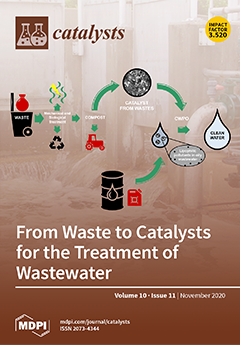In many heterogeneous catalytic reactions, such as low-temperature CO oxidation, the preparation conditions, and the role of the CeO
2 support (oxygen vacancies and redox properties) in the dispersion and the chemical state of Au, are considered critical factors for obtaining gold nanoparticle
[...] Read more.
In many heterogeneous catalytic reactions, such as low-temperature CO oxidation, the preparation conditions, and the role of the CeO
2 support (oxygen vacancies and redox properties) in the dispersion and the chemical state of Au, are considered critical factors for obtaining gold nanoparticle catalysts with high catalytic performance. In this work, the physical and chemical preparation methods were compared, aiming at understanding how the preparation method influences the catalytic activity. The Au/CeO
2 nanoparticle catalysts with 5% Au loading were prepared via the Physical Laser Vaporization Controlled Condensation method (LVCC), and the chemical Deposition-Precipitation method (DP) was used to investigate the effect of synthesis methods on the structure and the catalytic activity toward the CO oxidation. In this manuscript, we compare the activity of nanostructured Au/CeO
2 catalysts. The structure and the redox properties of the catalysts were investigated by the XRD, SEM, TEM, TPR, and XPS. The catalytic activity for low-temperature CO oxidation was studied using a custom-built quartz tube flow reactor coupled with an infrared detector system at atmospheric pressure. The study reveals that the prepared CeO
2-supported Au nanoparticles’ catalytic activity was highly dependent on the preparation methods. It showed that the sample prepared by the DP method exhibits higher catalytic efficiency toward CO oxidation when compared with the sample prepared by the LVCC method. The high catalytic activity could be attributed to the small particle size and shape, slightly higher Au concentration at the surface, surface-active Au species such as Au
1+, along with the large interface between Au and CeO
2. This study suggests that the stability, dispersion of Au nanoparticles on CeO
2, and strong interaction between Au and CeO
2 lead to strong oxidation ability even below room temperature. Considering the universal character of different physical and chemical methods for Au/CeO
2 preparation, this study may also provide a base for supported Au-based catalysts for many oxidation reactions in energy and environmental applications.
Full article





